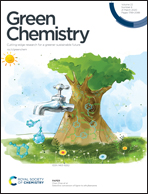An efficient hydrogenation catalytic model hosted in a stable hyper-crosslinked porous-organic-polymer: from fatty acid to bio-based alkane diesel synthesis†
Abstract
In this study, a Pd-based catalytic model over a nitrogen enriched fibrous Porous-Organic-Polymer (POP) is established to execute hydrodeoxygenation of various vegetable oils in producing potential large-scale renewable diesel. Here we report a cost-effective synthesis strategy for a new microporous hypercrosslinked POP through the FeCl3 assisted Friedel–Crafts alkylation reaction, followed by fabrication of Pd0-NPs (2–3 nm) using a solid gas phase hydrogenation route to deliver a novel catalytic system. This catalyst (called Pd@PPN) exhibits versatile catalytic performance for different types of vegetable oils including palm oil, soybean oil, sunflower oil and rapeseed oil to furnish long chain diesel range alkanes. The catalyst is comprehensively characterized using various spectroscopic tools and it shows high stability during five runs of recycling without leaching of Pd. Our results further reveal that a direct decarbonylation (DCN) pathway of fatty acids to produce alkanes with one fewer carbon is the dominant mechanism. Under optimized conditions, using stearic acid to represent the long linear carboxylic acids in the vegetable oils, up to 90% conversion with 83% selectivity of C17-alkane has been achieved on our fabricated catalyst. Density functional theory (DFT) calculations are performed to provide insights into the electronic properties of the catalyst, the mechanistic reaction pathway, the crucial role of the catalyst surface and the product selectivity trend. The strong interaction between the corrugated polymer-frame-structure and the Pd-NPs suggests the presence of high density step sites on the fabricated Pd-NP anchored within the cage of the polymer structure. DFT calculations also reveal the strong promotional effect of step sites and charge transfer in facilitating rate-limiting steps during the decarbonylation (DCN) pathway and removal of strongly bound intermediates formed during the process, therefore explaining the high activity of the fabricated Pd@PPN catayst for the hydrodeoxygenation (HDO) conversion to produce bio-based alkane diesel.



 Please wait while we load your content...
Please wait while we load your content...